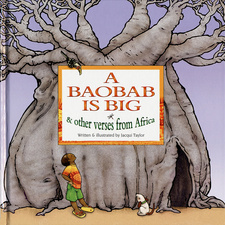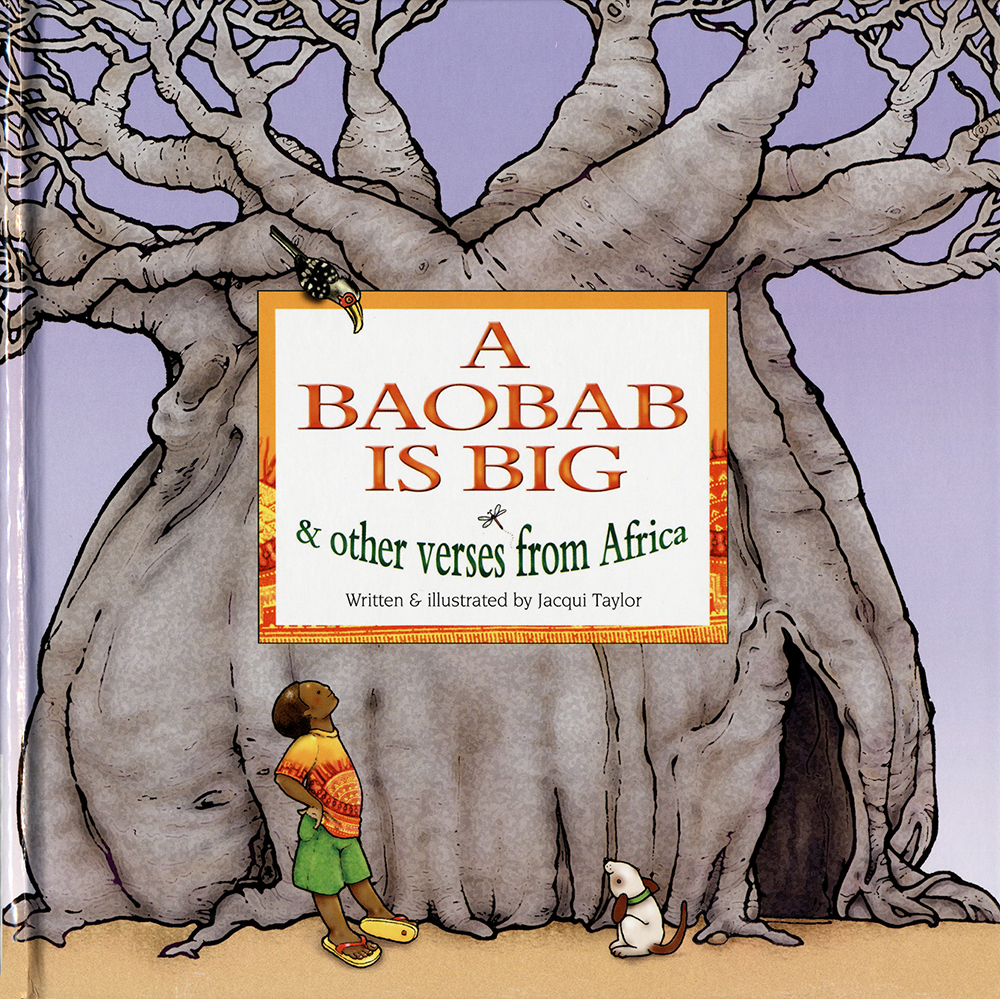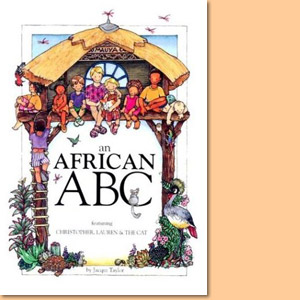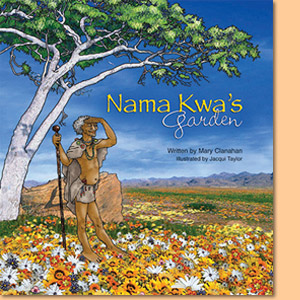A Baobab is Big and other verses from Africa, by Jacqui Taylor

A Baobab is Big and other verses from Africa, by Jacqui Taylor. Struik Publishers, Cape Town, South Africa 2004. ISBN 9781868729463 / ISBN 978-1-86872-946-3
As we already have cited Jacqui Taylor's poem A Baobab is Big in the book description, we decided to leave the other beautiful verses aside and to introduce one of the texts from the chapter Fascinating Facts, which is placed in the end of the book, instead.
The Baobab Tree
Botanical name:
ADANSONIA DIGITATA
Afrikaans name:
KREMETARTBOOM
Shona name: MUUYU
Ndebele name: UMKHOMO
The baobab is found in most countries south of the Sahara Desert ~ as far south as the Limpopo Province of South Africa, preferring hot areas with low rainfall. It is a huge deciduous tree that can grow up to 20 metres in height, while the trunk can reach a diameter of up to 12 metres. A baobab of this size may be well over 2,000 years old! Carbon dating of a tree in Zimbabwe, with a trunk diameter of 4.5 metres, proved the tree to be 1,010 years old. The trunk itself can be tall and bottle shaped, or quite short and squat, while the crown is usually round and spreading. The bark of the baobab is smooth and silvery, tinged with a coppery colour. It folds itself into wonderful shapes that look almost like melting wax. Because the baobab stores water in its trunk, elephants will strip the bark and chew it for moisture. The bark can be used in the making of baskets, rope and mats. Water may be tapped from the roots of the tree and the young roots are sometimes cooked and eaten. The leaves are dark green and hand shaped ~ they each have five leaflets that resemble fingers. In the winter season the tree loses its leaves. Many game animals eat the leaves of the baobab and cattle will eat the fallen leaves at the begining of winter. People cook the new leaves to make a dish similar to spinach. At the start of the rainy season, new leaves appear and the tree produces single flowers that are approximately the same size as a soup plate in diameter! The blooms hang down from the branches like big, white, waxy bells. They are pollinated by bushbabies, bats, bluebottles (a kind of fly) and moths, who are attracted by their scent of carrion (decaying meat). The pollen can be used to make glue but picking a baobab flower is thought to bring bad luck. Fruit appears on the tree at the beginning of the dry winter season. The seed pods are 10-15 centimetres in length and are roughly oval in shape. Covering the hard pod shell is yellowish, velvety hair. Inside are brown, kidney-shaped seeds that are covered with a creamy-white, dry pith called 'cream of tartar', which contains lots of vitamin C and tartaric acid. This pith can be licked off or used to make a refreshing drink. The seeds can even be roasted, ground and used as a substitute for coffee or may be used to flavour soups and stews. Sometimes, a baobab will trap a small reservoir of water high in its branches. This well will be visited by many animals and birds during the dry season.
This is an excerpt from A Baobab is Big and other verses from Africa, by Jacqui Taylor.
Title: A Baobab is Big and other verses from Africa
Author: Jacqui Taylor
Genre: Children's book, Poetry
Publisher: Struik Publishers
Cape Town, South Africa 2004
ISBN 9781868729463 / ISBN 978-1-86872-946-3
Hardcover, 20 x 20 cm, 80 pages, throughout illustrated
Taylor, Jacqui im Namibiana-Buchangebot
A Baobab is Big and other verses from Africa
A Baobab is Big and other verses from Africa is a beautiful, fun and perceptive celebration of African images and themes as seen from a child's perspective.
An African ABC
Imaginatively written and colorfully illustrated, An African ABC is one of those rare ABC books that can be as enthusiastically recommended.
Nama Kwa's Garden
Inspired by the almost magical transformation of the Namaqualand region in spring, Mary Clanahan has created a tale of natural wonder for children.



